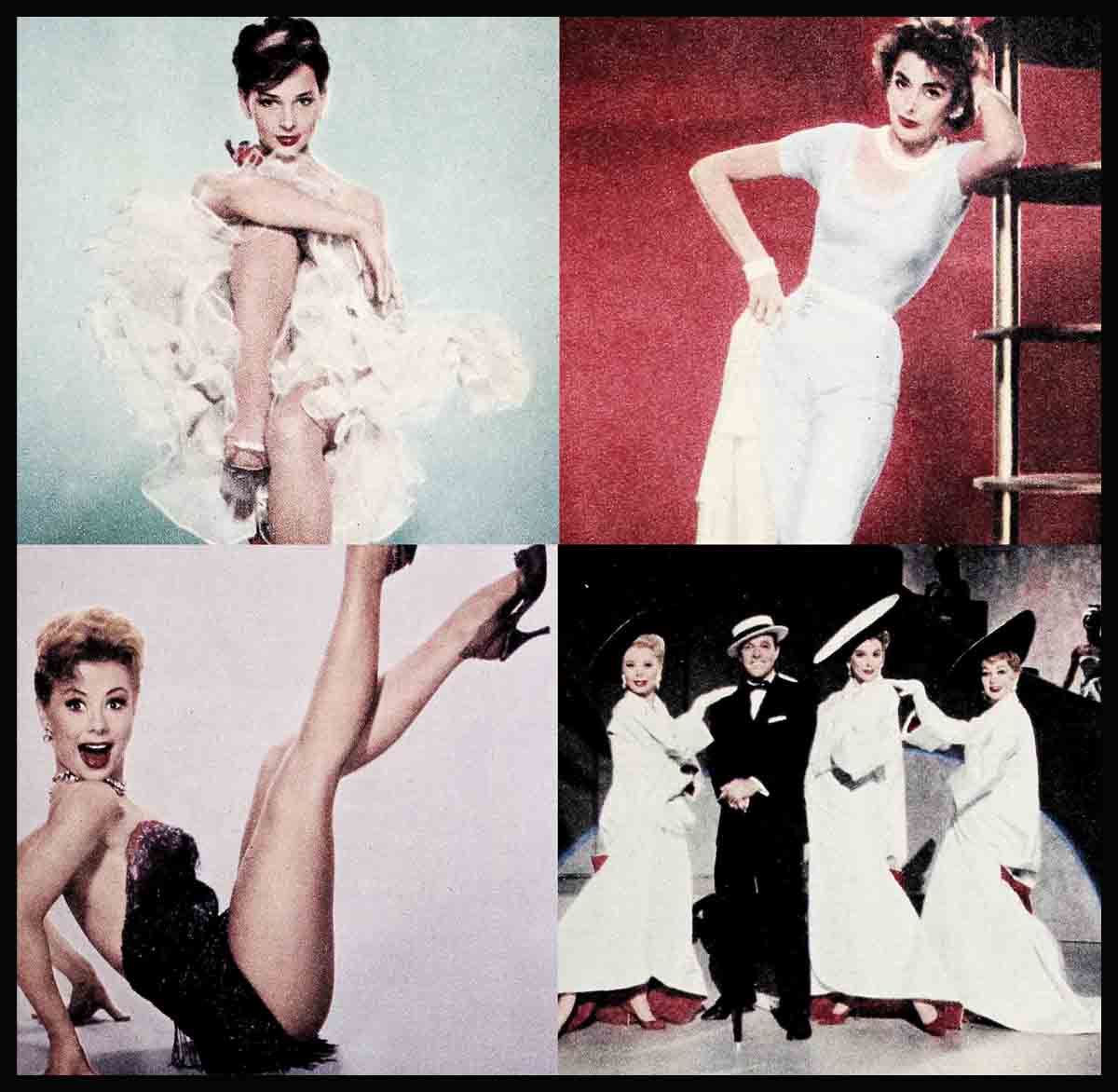
Who’s Telling The Truth?
Everybody’s talking about a guy and three gals: Gene Kelly and “Les Girls,” Kay Kendall, Mitzi Gaynor and Taina Elg. If you’re on your toes, you’ve already heard the hilariously conflicting stories given in the movie. Kay pictures Taina as a sexy minx in love with Gene; Taina accuses Kay of being smitten with Gene and becoming a lovelorn drunk; Gene says they’re all nice girls, but he loves Mitzi; Mitzi doesn’t say anything. But if you haven’t seen “Les Girls”—well, don’t just sit there! Put down this magazine and get out of the house and go see it! . . .
Okay, now where were we? Oh, yes . . . everybody’s talking, so it’s about time the stars of “Les Girls” did some talking about themselves and each other, from the personal point of view. And whose story in the film do they think really was the truth? So let’s meet the people—and get set for some surprises!
Take Britain’s statuesque Kay Kendall (five feet eight, with splendid measurements to match). Fans who play the J. Arthur Rank circuit will remember her as the sumptuous photographers’ model in “Genevieve,” the stand-offish babe who finally got loaded on champagne and stood up to play a good hot trumpet. She was a model again in “Doctor in the House,” too expensive for our poor hero to afford. And she helped Robert Taylor kid the pants off Sir Walter Scott, in the gaily burlesque movie version of “Quentin Durward.”
Since the release of “Les Girls,” reviewers have been wearing out their Websters in search of new superlatives to heap upon Kay’s pretty head. These run from “a polished, aristocratic beauty with the greatest comic flair since Beatrice Lillie,” to a single, but highly descriptive word: “Wow!” And for good measure, Kay has garnered plenty of sweet publicity as the adored lady of that adored idol of “My Fair Lady,” none other than smooth, sophisticated Rex Harrison.
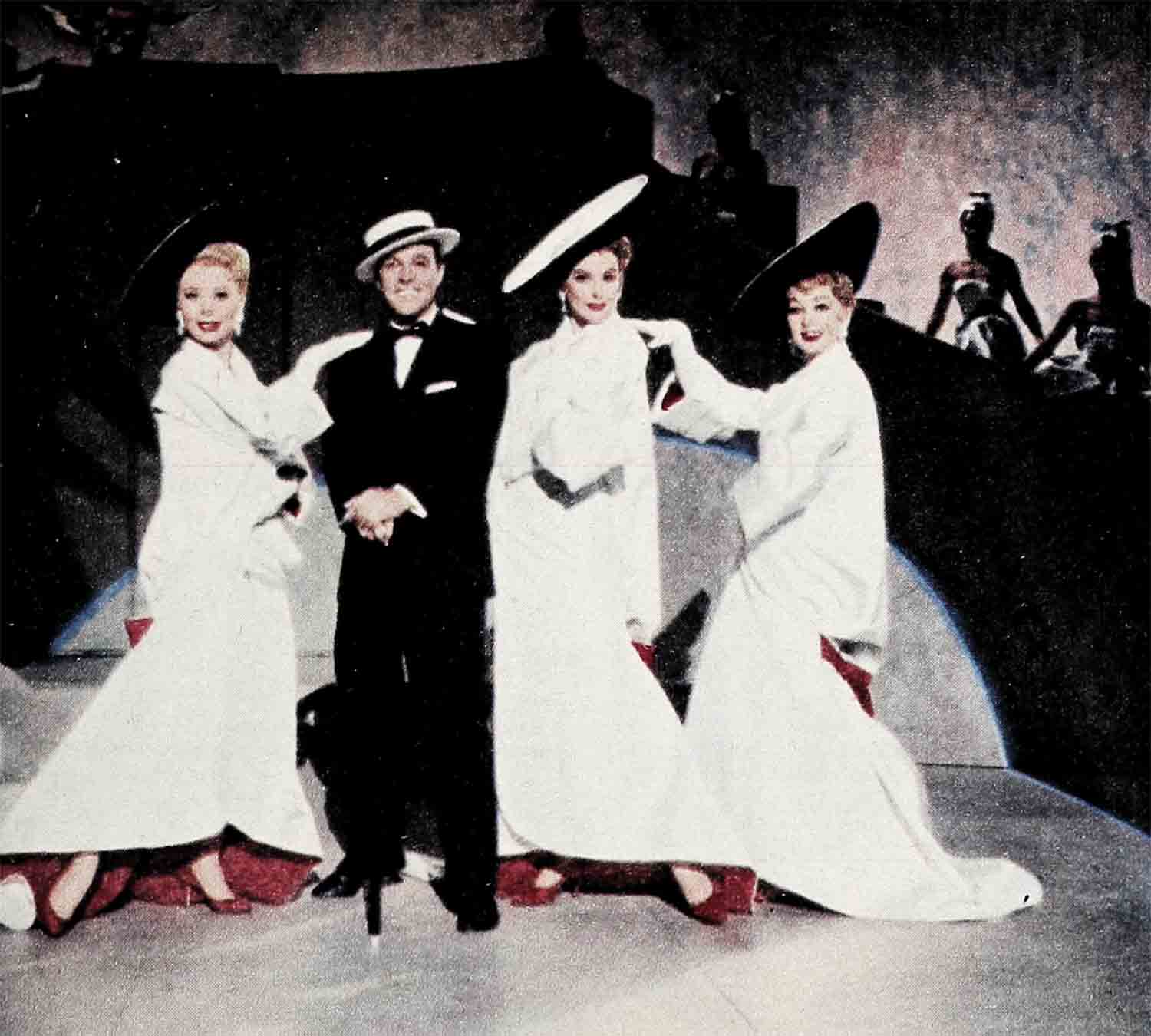
Here’s a pretty ritzy type, wouldn’t you say? If you would, you’d be so wrong! An intimate friend reports, “Kay is anything but the flamboyant person people believe her to be. She’s actually shy, and more than a little self-conscious. The truth is that the only person who stopped Kay from scoring a whopping success long ago was Kay herself. She’s very self-effacing, and has a real complex about her looks—thinks she’s too tall, and not a bit pretty. Why, she could hardly bring herself to come to America for that reason. She’d say, “Those American girls are all so beautiful. How can I ever compete with them?’ ”
Taina Elg agrees that Kay is really shy, but like all who get to know her well, found she’s warm and friendly. ‘“We’d often have lunch together,” Taina says.
Champagne and pheasant under glass, perhaps? The sleek and haughty-looking Miss Kendall conjures up such visions. “Not a bit of it,” laughs Taina. “Usually, we’d just bring something from home and eat in Kay’s dressing room. We had a feast of fun and laughs—Kay has a terrific sense of humor.
“At the time we made the picture, she wasn’t married to Rex Harrison,” Taina adds thoughtfully. “But she knew she was going to be, and she looked forward to it. I often had the feeling that she wished at that time she was in our shoes.”
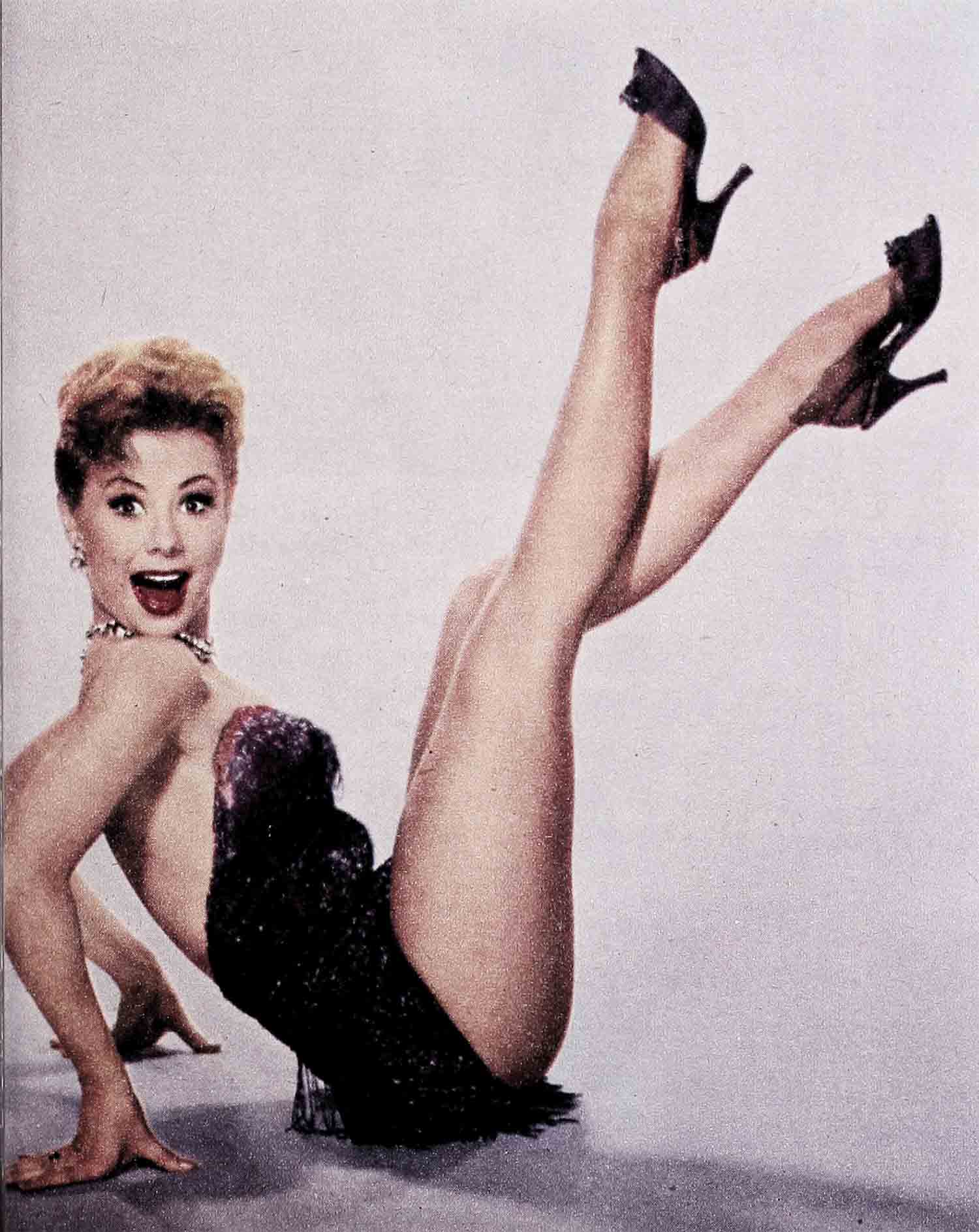
Whose shoes? Finnish-born Taina, the toothsome “French” pastry of “Les Girls,” is the wife of home-town boy Carl Bjorkenheim (from Helsinki, but now an American citizen). America’s Mitzi Gaynor is married to agent Jack Bean. And Kay, hailed as anything but the homey type, in reality was looking with wistful longing on the settled home-and-fireside domesticity of her feminine co-stars!
Lunch-times, there’d be four people having a ball in Kay’s dressing room; the witty “hostess,” M-G-M publicity man Morgan Hudgins, Jacques Bergerac (Taina’s handsome leading man in the movie, Ginger Rogers’ latest ex offscreen) and Taina.
Where was Mitzi? You’d expect that bubbling pixie to be the most sociable member of the group. But no. During the lunch hour, she was holed up in her own dressing room, determinedly munching a health salad to preserve her slender figure. This Spartan routine was hard-won; Mitzi used to be a pretty little butter-ball. So she turned her back on temptation and faithfully ate her health salad, studying her lines and occasionally giving interviews between bites while the laughs rang out from Kendall’s at-home-at-the-studio sessions. She had another reason for her cloistered dedication, too. Her next job was the coveted role of Nellie Forbush in “South Pacific.”
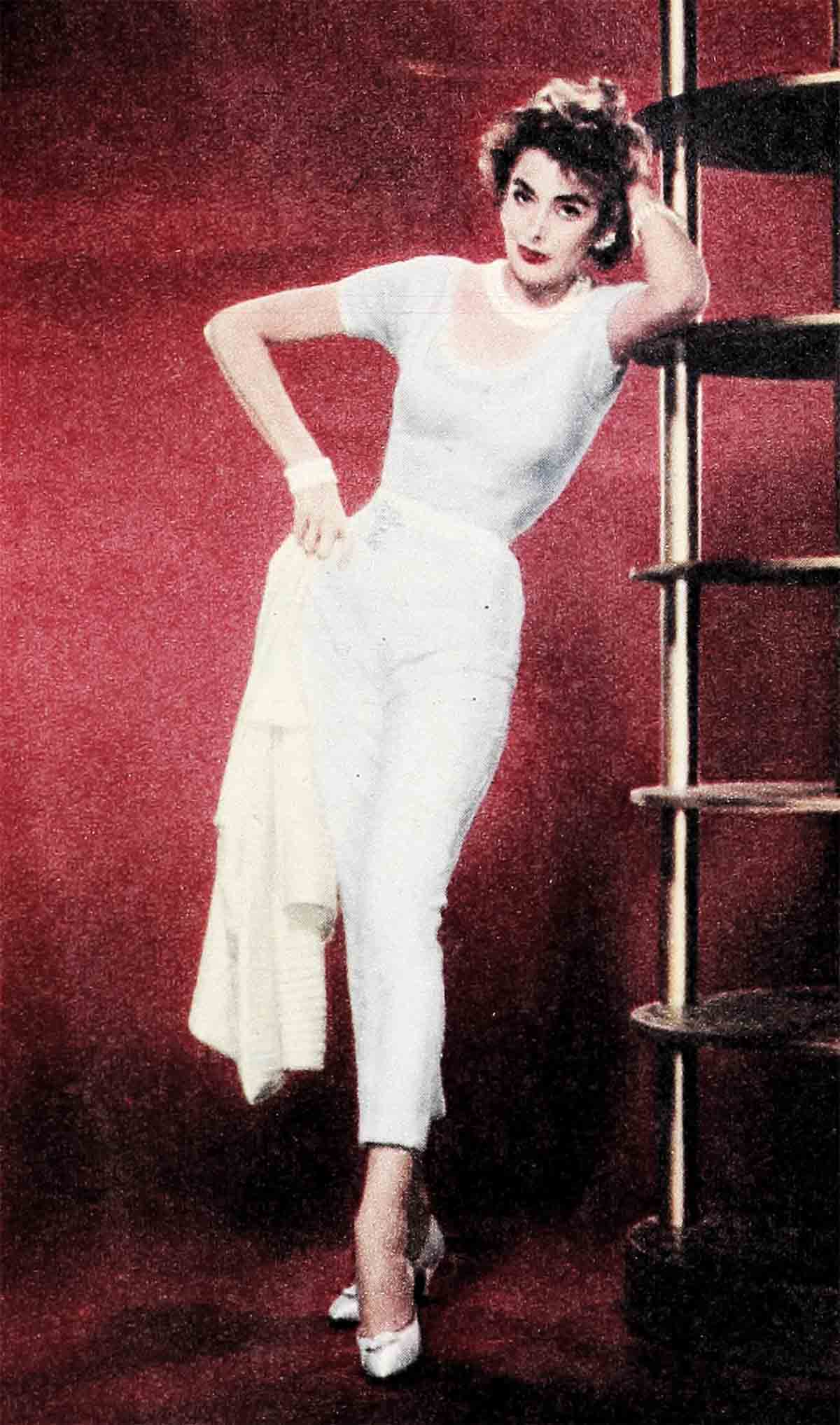
Let’s not forget; there was a man in the house, top man in the movie, the knowing and coolly whimsical Gene Kelly. With his experience at dancing, directing and acting, Gene got mostly respect from his three movie ladies. Even if there had been time during the production of an important musical for the comparing of marital notes, he would hardly have been in tune with his romantic-minded co-stars. His marriage to Betsy Blair ended in divorce, but not—from Gene’s point of view—in bitterness. As a precious souvenir of a love match that went wrong, there’s daughter Kerry, fourteen—“a good kid, thank heavens!” says Gene.
Of Gene, Taina says gratefully: “It was pleasant to work with Mr. Kelly. He’s very professional, and I think I got some hints on acting that I needed.”
Says Kay: “Mr. Kelly was most helpful. Mitzi, too, helped me with the dancing. I am not a dancer, but all of them—Mr. Kelly, Mitzi and Taina—are fine dancers and took me into the fold and helped me enormously.”
Says Mitzi: Nothing.
Search as you will, you could hardly find three actresses more different than these—or more different from the roles they play: Kay, the self-deprecating about-to-be bride; Taina, the gentle young wife and mother; Mitzi, the contented wife and determined career woman. (Yes, there is such a combination; don’t believe what the movies say. After all, when you’ve seen “Les Girls,” what can you believe?)
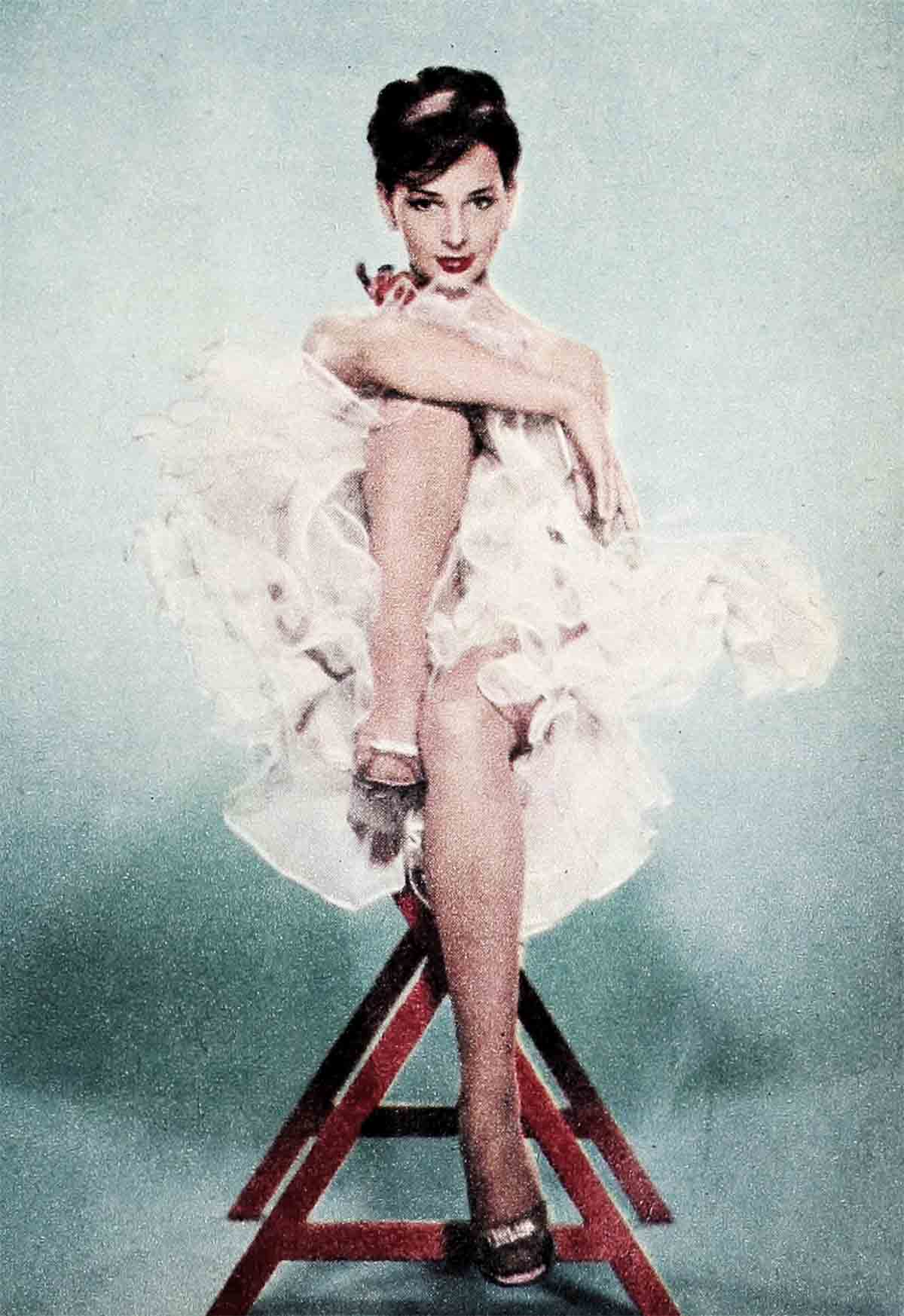
But our three “Girls” do have some things in common: Each one has had a delayed-action career, now sparked into brilliant life by this picture; and each one is equipped by heritage for the future she faces. Fans reacted promptly to Mitzi’s likable screen presence when she played the hearty Texan in “Take Care of My Little Girl.” Nothing terribly impressive happened to Mitzi after that. Still, she wasn’t concerned. This Chicago-born girl, raised in Detroit and Hollywood, has a dancer mother and a dance-director father, and the vagaries of show business don’t surprise her. Mitzi could wait—and watch her weight, to be ready for the chance she was sure was coming.
Kay Kendall was born to show business, the daughter of dancer parents. But she got off to a slow start in British movies. While such as the flashy—and much more aggressive—Diana Dors basked in the limelight, Kay was barely noticed.
Taina had a big build-up when she played Lana Turner’s hand-maiden in “The Prodigal.” Nothing much happened to her, either. Born of pianist parents, she was wise to show biz, too. (“But I’m the family black sheep,” she laughs. “Can’t play a note!”) During the cozy lunchtimes in Kay’s dressing room, they’d kick the shop talk around, and the English girl’s experiences turned out to be similar: drafty backstage rooms in plays that were doomed to close fast; old, tired sandwiches for supper.
Now here they all were in the big time: the guy from Pittsburgh, the girl from Helsinki, the girl from London, the girl from Chicago. Gay as the result is, for the people who brought you this delightful movie there was only one way to achieve it—hard work!
“As the poem says,” Kay remarks dryly, “morning was certainly at seven. So was the evening. By that time, if I was lucky, I was back at the Beverly Hills Hotel.”
“I had to be at the studio at seven,” Taina chimes in. “At nine o’clock exactly, we started shooting. We worked until lunch, then after lunch until six, sometimes seven. In the morning, I’d just have a peek at my baby, Raoul. In the evening, I’d play with him. I have a nurse for him, but at that time I didn’t have a cook. On my way home from the studio, I’d stop at the grocery and pick up the food for dinner, and then cook it—unless I was too tired. On those nights, Carl would go out to our favorite hamburger place and bring home hamburgers. He’s mad about hamburgers!”
Says Mitzi: Nothing.
From the beginning of shooting, it was Kay who set the happy mood. At least, so says Taina. “Kay’s so spontaneous and beautiful and glamorous and talented—and everything! She spoiled everyone by splurging on gifts. On the starting day, Mr. Kelly wasn’t there, and he forgot to send his leading ladies flowers. So when he came in the next day, Kay (who had met him in London) deluged him with flowers and wires saying, ‘Good luck on your picture.’
Still, approaching the high point in her career, looking forward to her wedding, Kay retained an endearing sense of humility. Taina tells another revealing story about her: “Once she mentioned to Bing Crosby that she loved a specific song of his, but couldn’t buy it. Why? ‘Probably,’ Bing said, ‘because it’s so old.’ Then he went to a recording studio and recorded it especially for her. For Kay, this was the most marvelous thing that could happen. She couldn’t get over it—that anyone could do such a nice thing for her. She was in heaven!”
Although Taina speaks glowingly of Kay, her baby Raoul and husband Carl, she speaks little about herself. Partly out of natural modesty, but mainly because she does not like to be questioned about her past—it is a story still painful for her to tell. Where her home in Finland lay, the Russians fought. When the Finns drove them out, her family found another home—only to have it fall into Russian hands again when Finland was partitioned. It was very hard on her mother, who is Russian, and who, after they had fled to safety, learned that thirteen members of her family who were forced to stay behind had lost their lives. Now, the simple life and peace with her little family in California is all that Taina ever wants.
And what does Mitzi want? Nothing less than to become the great star that she now has a chance to be. Mitzi knows by bitter experience how rare such opportunities are—she has cooled her talented tootsies long enough waiting. And for this end, she will work like a demon, and make every sacrifice. “This girl is a glutton for punishment,” remarks an admiring technician. “She’ll dance until she drops, and sing until you think she can’t get out another note. She’s never satisfied with anything but perfection.”
Quite a contrast, with the roles they play on the screen, isn’t it? No haughty lady is Kay; no sly, sexy minx is Taina; no pixie hoyden is Mitzi.
But about that picture—which of the stories in “Les Girls” is true?
“My own story, of course,” says Taina.
“The one I told, of course,” say Kay.
From Mitzi: “No comment.” But the lady’s only being consistent. The girl in the picture never gives her own side of the story, either.
So-o, Mr. Kelly, which story do you think is true? “None of them,” says Gene, blandly, getting off the hook. “They were all covering up. But in real life I think men are naturally more truthful than women. I don’t mean this derogatorily. A woman is a coquette from the time she can toddle, and this lasts all her life. Let’s not say she abuses truth more than man, but let’s admit she bends it a bit more often. When it comes to a big lie, men are worse. But we’d sooner be lied to by a woman than a man.”
Now that Gene’s thrown that bomb, who gets the last word? You do. Says Mr. Kelly: “We wanted the audience to think and decide for themselves.” Go ahead, girls—and have fun!
THE END
—BY HILDEGARDE JOHNSON
It is a quote. PHOTOPLAY MAGAZINE JANUARY 1958


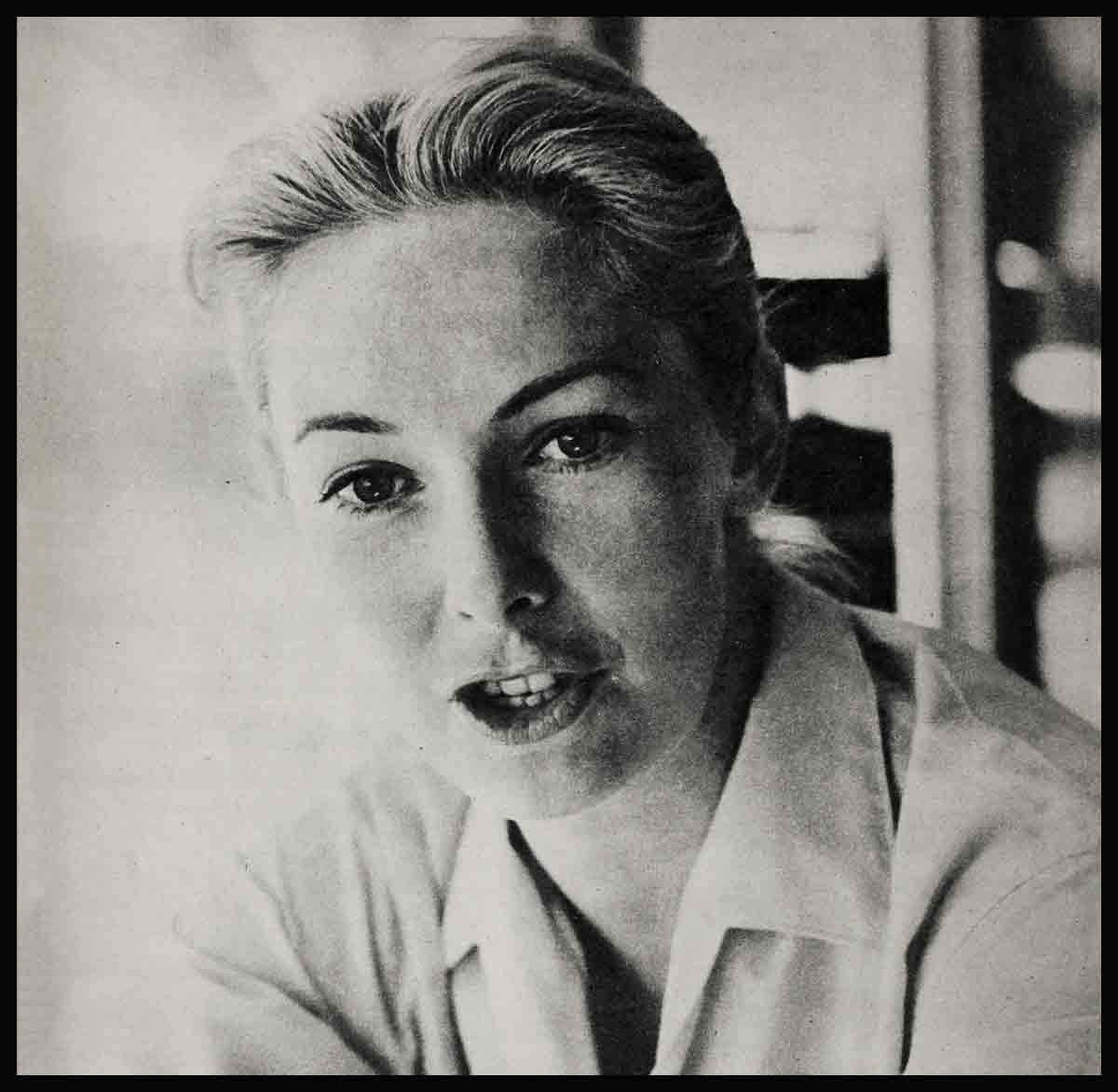

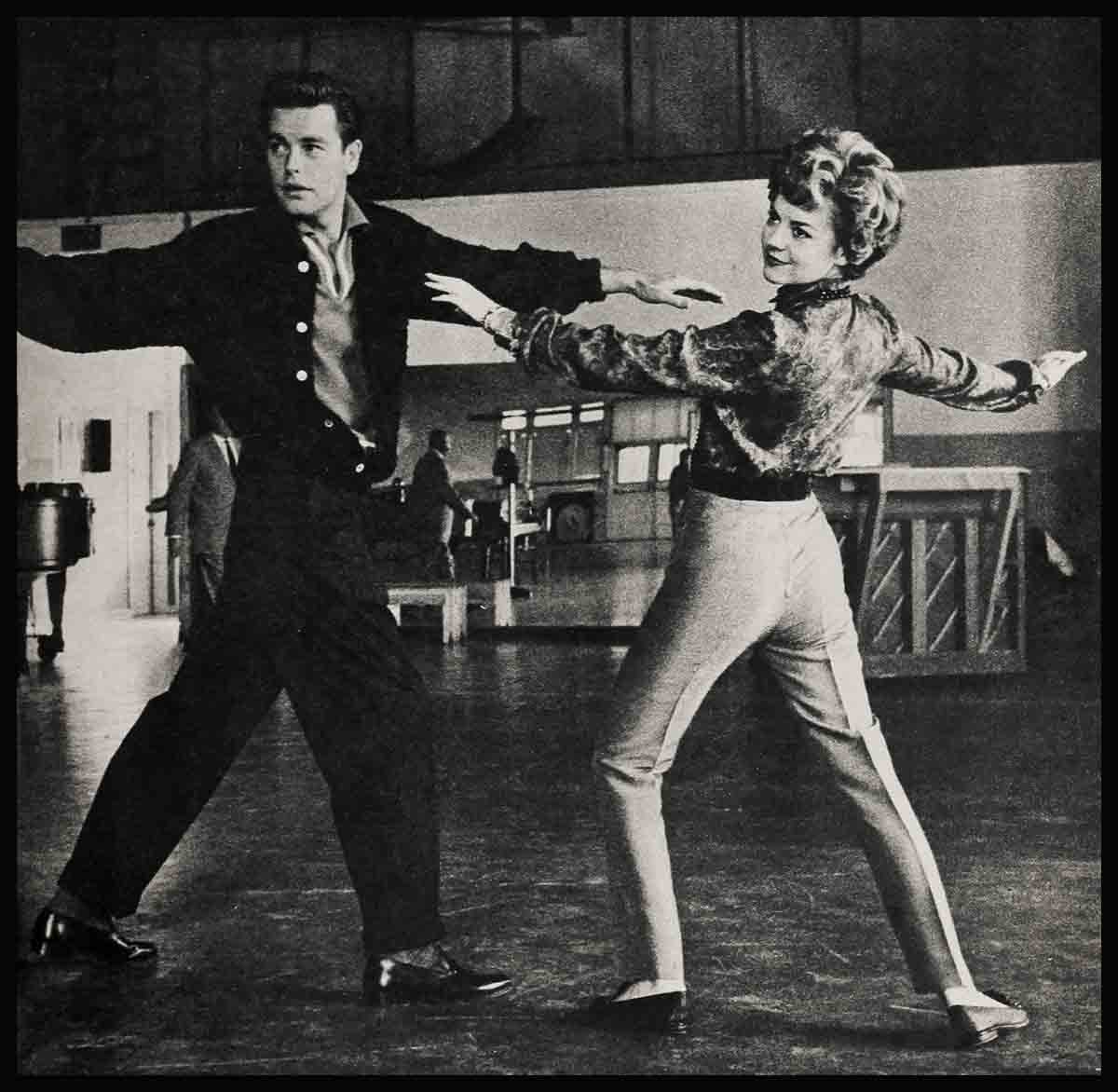
No Comments